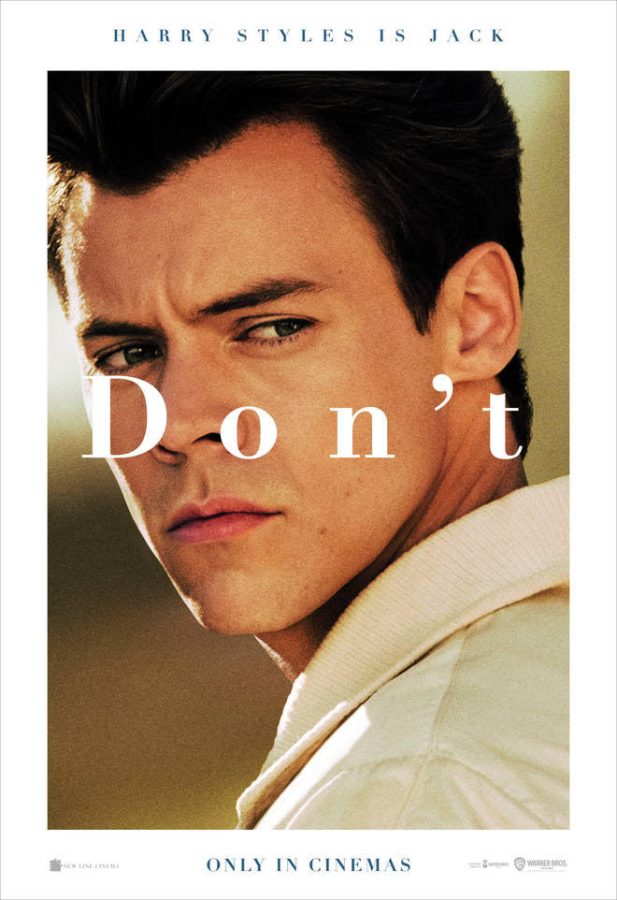Darling, we’re worried: does this movie go too far?
Harry Styles stars as Jack Chambers in Don’t Worry Darling (Photo courtesy of Capital Film).
November 2, 2022
The movie Don’t Worry Darling is an eye-catching, psychological thriller that excited and thrilled audiences as they understood and questioned the true meaning of the film. Released on Sept 22 and directed by Olivia Wilde.
Florence Pugh, the lead actress of the film, played a curious and clueless housewife (Alice Chambers) whose husband has been keeping a massive secret from her. The pure, raw talent of Pugh is the most fan-captivating aspect of the movie. She does a great job showing how emotionally and physically aware her character’s actions are in the movie.
The setting takes place during the 1950s, in a small town called Victory. The mystery of the story revolves around “The Victories Project,” which is almost impossible for audiences to solve its meaning. The constant nail-biting suspicion is what keeps the audience members on the edge of their seats.
Pugh’s husband Jack Chambers (Harry Styles) does a great job building the suspicion behind what “The Victory Project” is about. Considering this was his first serious role in a film, Styles shows great potential and room for growth in acting besides a couple of awkwardly acted scenes from him. The chemistry in the whole movie between Pugh and Styles is exceptional, making it hard to look away.
This film includes many other outstanding actors and familiar faces like Chris Pine, Gemma Chan, Kiki Layne and many more. What sets this movie apart from other psychological thrillers is the plot twist audiences would never expect. Abbigayle Gabli, a Senior, really enjoyed the movie. ”The plot twist was creative,” Gabli said, “And it’s something that I haven’t seen done before.” It’s easy to guess the ending of most movies, but this was the only psychological thriller they seriously could not guess the ending of.
The film’s dark tone, use of flashbacks and subtle foreshadowing has viewers questioning themselves repeatedly. “I didn’t know what was going to happen. ” Senior Sabrina Girardi said.
The movie has a much bigger meaning than just an ordinary unexpected thriller: it’s also connected to feminism. “It was such a good generalization of women,” Giradi said. “And I also thought it was so interesting how the one character [Bunny, played by Olivia Wilde] chose to be in a man’s world. And how she could betray all of the women.”
Gabli attested to the exploration of themes of femininity in modern times. “It showcased how women feel in society today, and I feel if even a small majority don’t feel the same way it gave them a glimpse into the impurity that is being a woman in the United States,” Gabli said. Many viewers resonated with the female characters’ anger.
The soundtrack is what also really brings the viewers in. The songs set the mood as the movie goes on and makes the scenes way more captivating. Songs like “The Oogum Boogum Song” by Brenton Wood, “Someone To Watch Over Me” by Ella Fitzgeraldv and “Tears On My Pillow” by Little Anthony & The Imperials all are featured in the film. “I liked how there was one song in pieces of the movie and then it came together in the end like a puzzle piece,” Gabli said. Much of the soundtrack was connected to subtle metaphors within the movie.
Some people in the film industry associate movies with colors. Viewers of Don’t Worry Darling illustrated the color that defined the movie for them.
“[I associate Don’t Worry Darling with] Black because it is all the colors mixed together, being all the plot twists and the different aspects that equaled black,” Girardi said.
“Gray” Senior Megan Hotchkiss said. “There were still a lot of gray areas that left me with some questions. ”
Styles himself thinks the movie’s color is red because of the deep psychological events that take place and the constant crimes.
